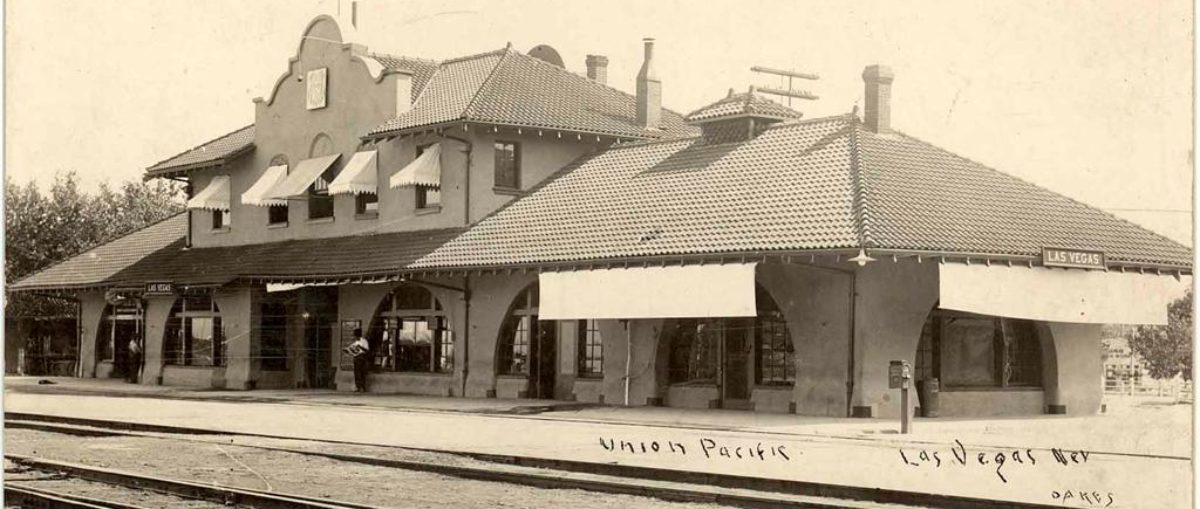“Jay’s Cottages,” located at Elko, Nevada
20 Post Cards Mark the History of Jay’s Cottages,
1313 Idaho Street, Elko, Nevada.
By Bob Stoldal
Updated June 14, 2020
Starting with a service station in 1925, Jacinto “Jay” and his wife Lucile Garteiz, over the next four decades, would raise a family and build what was described as “the largest accommodation in the City of Elko for the traveling public.”[i]
The “accommodations,” known as “Jay’s Cottages,” in the 1940’s and 50’s would cover both sides of one city block on the eastern edge of Elko, Nevada.
In addition to “Jay’s Service Station,” and a stand alone restaurant, the motel, at its peak had 149 rooms, all with television, including some with “color” as well as rooms “equipped with Englander Air-Foam Mattresses.” [ii]
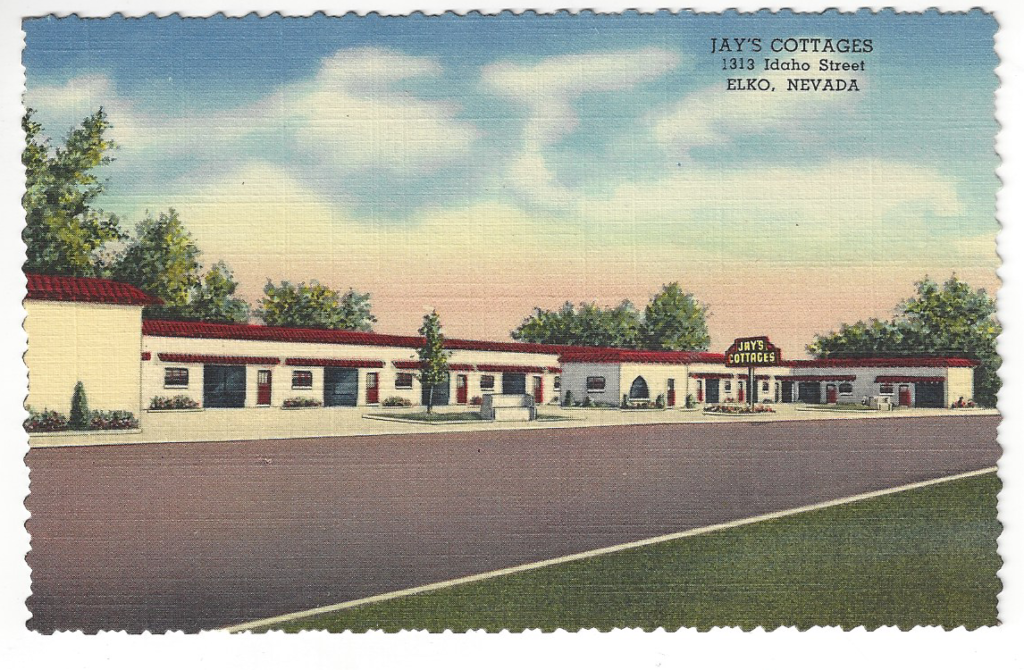
Garteiz was born in Bermeo, Spain in 1896, and immigrated to the United States as a teenager in 1914.
Lucile Dixon Garteiz was born in Ogden Utah in 1898. Her father was a conductor for the Southern Pacific Railroad.
Jay Garteiz moved to Nevada in time to register for the World War One draft on June 5, 1918.
At registration, Garteiz said he was a “declarant” adding “I have declared my intention” to becoming a U.S. Citizen.
Garteiz worked for Standard Oil as a bookkeeper in East Ely, Nevada when he registered for military service.
He told the local draft board he was 21 years old, of medium height and build, had gray eyes and brown hair.
Garteiz stayed at the Steptoe Hotel on Main Street while he lived in Ely.
He would later move to Ogden where he worked for the railroad in an unknown capacity.
While working on the railroad he met Lucile Dixon. She was working as a stenographer at the time.
The two were married in 1921.
In early 1925 shortly before his 29th birthday, Garteiz moved Lucile and their new son to Elko with plans to open a service station.
On Garteiz’s 29th birthday, July 3, 1925 the Elko Daily Free Press reported; “Jay’s Service Station, located at Fifth and Idaho Streets, is the latest addition to the fast-growing gasoline and oil business in Elko. “Jay” who is J. Garteiz has spared no expense to give Elko one of the most up-to-date service stations in eastern Nevada. Mr. Garteiz is an old hand at the game, having been in charge of several stations for Standard Oil Company along the Pacific coast. The new station can provide the public with the very latest in gasoline and oil pumps and is equipped to drain cars and clean out crankcases. Ladies’ and gentlemen’s restrooms are also provided.”[iii]
A year after Mr. and Mrs. Garteiz moved to Elko, State the Federal government began numbering U. S. highways.
What was once called Nevada State Route 1, and the “Victory Highway” became U.S. Route 40. [iv]
Today U.S. Interstate 80 follows the same path across Nevada through Elko to Utah.
Records show over the next decade, Jay and Lucile became deeply involved in Elko community life.
From civic organizations to marketing efforts promoting the benefits of the area to the motoring public Lucile was an active partner in the operation.
She joined the Elko Business and Professional Woman’s Club, while Jay joined organizations promoting the Victory and U.S. Highway 40.
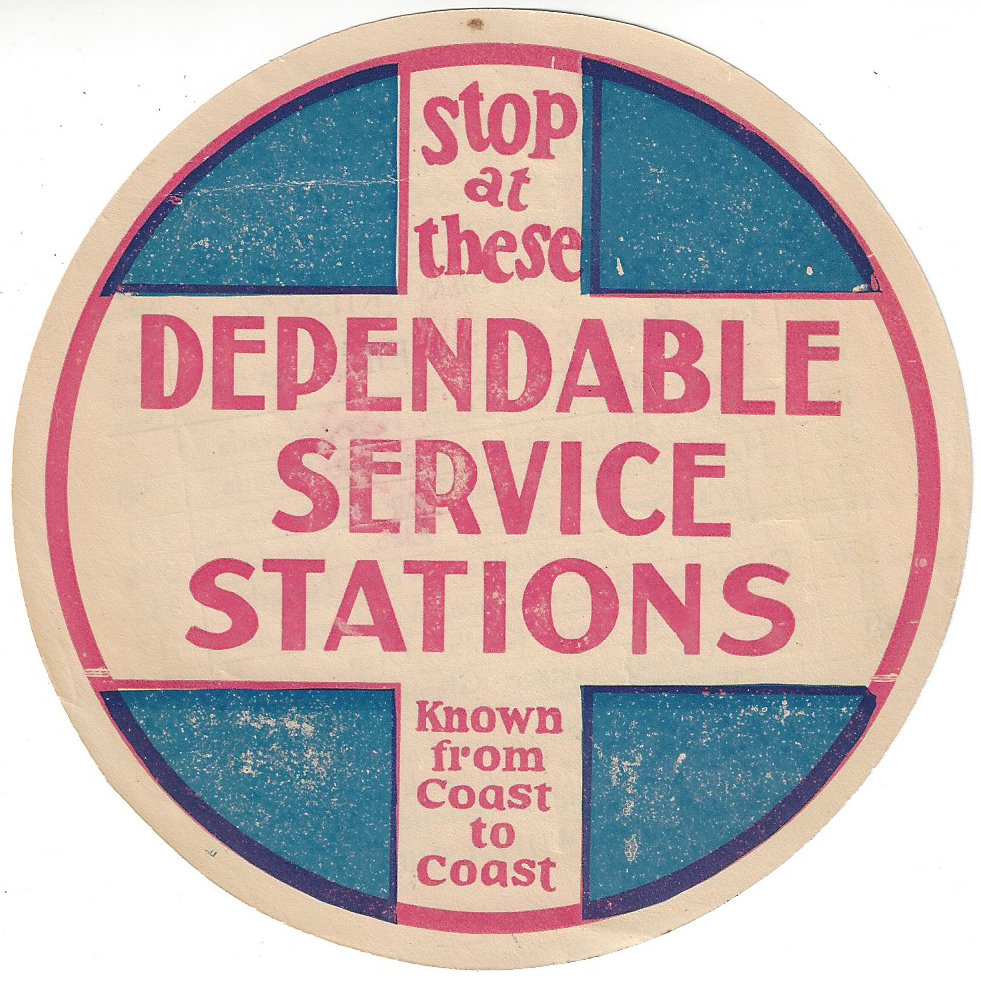
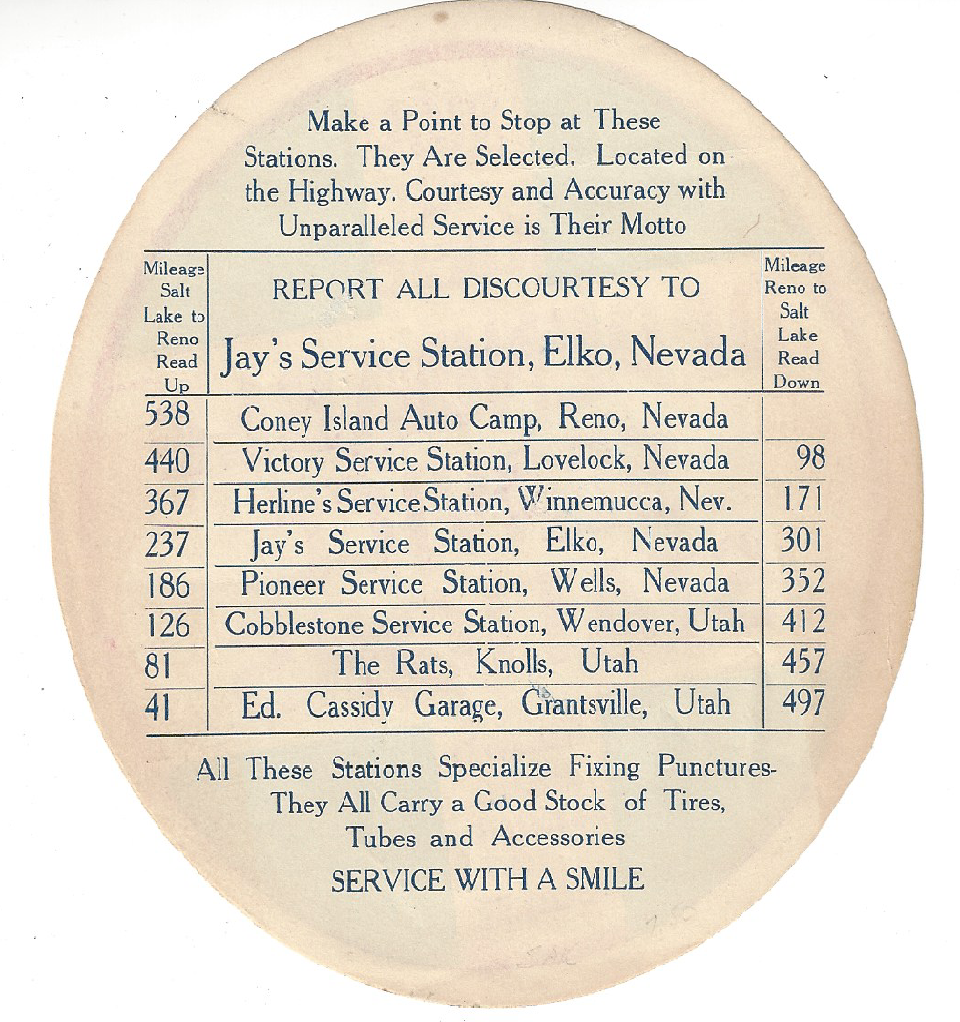
It is clear the two, and their two sons Raymond and Paul, and daughter Dorothy, had decided to make the largest city in north east Nevada community their home.
In early 1936 Garteiz made his first attempt to get into the auto court business when he tried to buy the cabins owned by the City of Elko.
At the time, Elko was running a camp ground for the motoring public. But in March of 1936 the city announced it would get out of the “camp ground business” in two years.
Garteiz in his letter to the Elko City Council, said the “camp is not a credit to the city and promised to build attractive grounds in the event he bought the cabins. He planned to move them to his property” according to a newspaper report.[v]
The city wrote back that Garteiz was too late, it had already leased the public camp out for the remaining two years at $50 dollars a month.
Despite the setback, Garteiz moved forward with his expansion plans. In 1938, he moved into the developing motel industry by making a “modest” investment and opening six “cottages” behind his Shell gas station.
An undated map sponsored by Garteiz, says he has “six new modern, air-cooled cabins and offers full Shell and Goodyear Tires sales and service.”

The map and information, according to the card was produced by “a group of progressive men who have cooperated together for years in giving high-class automotive service to tourists and others.”
The map extends from Salt Lake City on the east to Reno on the west. It should be noted there was not a “progressive” man in Wells. Leaving the automotive tourist with no “high-class automotive service,” for more than 112 miles.

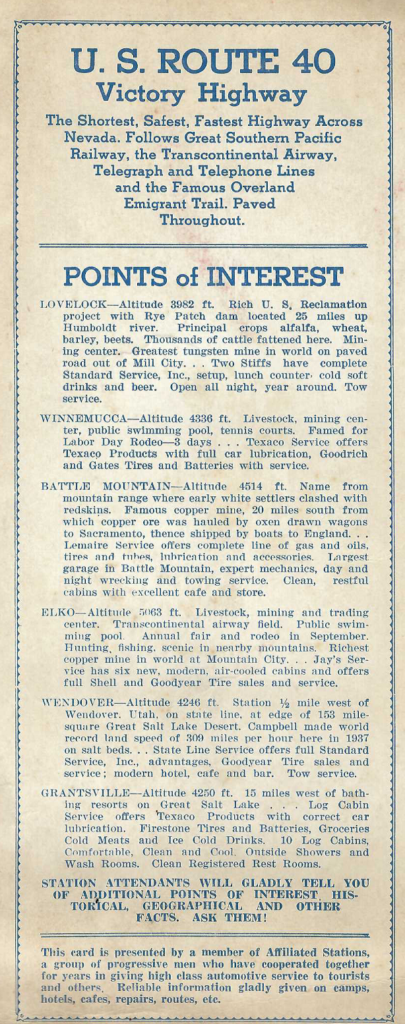
World War Two put a stop to his expansion plans.
Both of his son’s Raymond and Paul, served in the U.S. Navy. Raymond, who flew 20 combat missions returned to Elko.
His younger brother Paul after his discharge from the Navy, left for Hollywood hoping his musical skills would provide an entry to the film industry. After a couple of tours with the USO in a company headlined by Raymond Burr, Gartiez’s dream didn’t quite come true. His last major outing was headlining travel trade shows with his musical comedy act.
He was only 54 when he died.
In 1946, Jay, Lucile with their daughter Dorothy, and son Ray developed plan to aggressively move into motel business.
The plan had two stages. First, build a motel across the street from the gas station.
Once the motel was built, tear down the original six cottages and build a two story motel.
The long term plan called for the eventual expansion of “Jay’s Cottages” from six to 140 units.
A story in the July, 24, 1946 issue of the Elko Daily Free Press revealed part of the plan; “a new motel with 46 rooms will be opened in the spring, according to owner Jay Gardez. The motel will be built across from his present motel at 1313 Idaho Street.” [vi]
By the time the “cottages” opened in 1948, the 46 rooms had grown to 50 and instead of the individual units, the rooms were part of one long structure with closed garages between each unit was built.
The architecture was described as “mission style.” [vii]
Garteiz clearly saw the value of marketing, though his membership in both the “Victory Highway Association,” and the “Highway 40 Association.”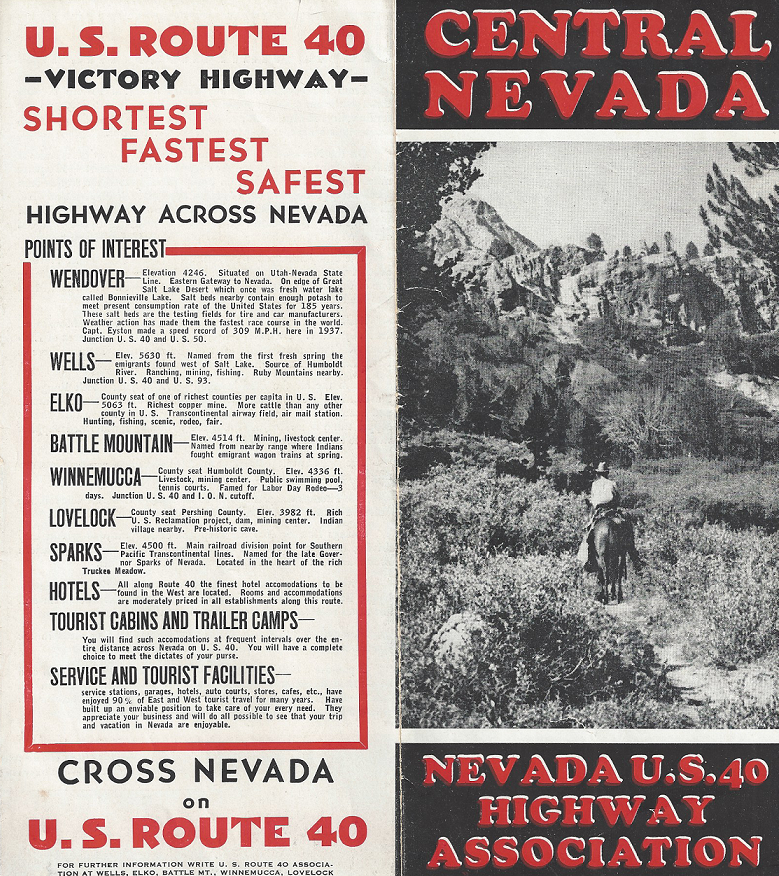
While he used brochures and decals to promote his service station, initially Garteiz did not use post cards to promote either his service station or his motel operations.
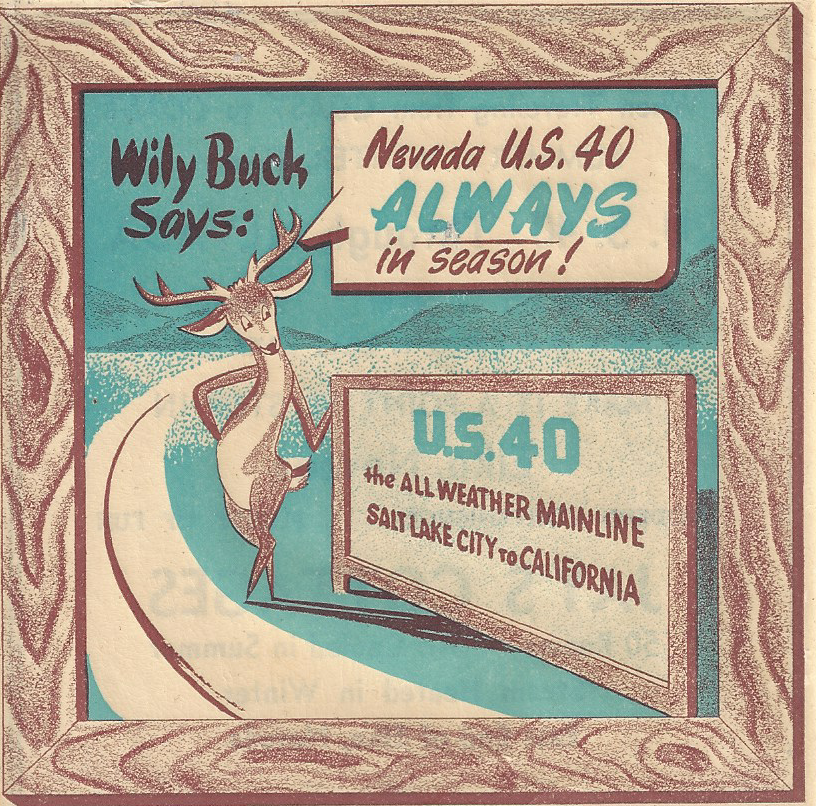
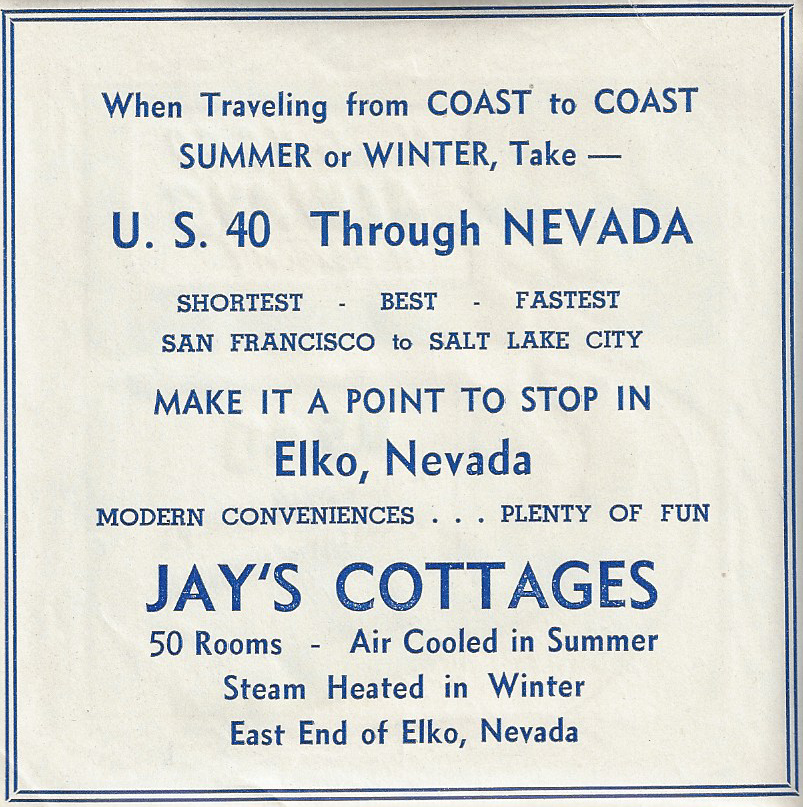
But, when he made his move into post cards, he did it in a big way.
Garteiz contacted to the Curt Tiech Company of Chicago, Illinois, at the time the largest post card company in the United States.
Jay’s Cottages – Curt Tiech Post Cards


The Curt Tiech production logs for “Elko, Nevada, reveals Garteiz ordered linen post cards in late 1947.
The post cards were given a C.T. alphanumeric number of 7B-H1969.
In 1930, the company started using a letter of the alphabet to signify the decade; “An” equals 1930, B equals 1940, etc.
The 7B meant Garteiz’s post card was produced in 1947.
The “H” means the post card was printed on what is commonly referred to as “linen” paper, and the number at the end, 1969, simply meant this was the 1,969th different postcards Curt Tiech printed that year.
The “Jay’s Cottages” post card was entered on the Teich log on “12-1-1947” indicting the Elko card was one of the last post cards Curt Teich printed that year.”[viii]
The logs also reveal “Jay’s Cottages” was the last post card of Elko printed by the Chicago Company.
Looking for the best price and with plans to use the post card for several years, Garteiz placed an order for twenty-five thousand cards.[ix]
He also ordered his post cards with deckled, or as they are sometimes called, ‘scalloped’ edges.

What did Garteiz have Teich print, if anything, on the back of the post cards?
While he placed an order for 25,000 post cards, it is likely he only printed a few thousand at a time. Garteiz knew he was going to expand his operations and the captions on the back of the post cards would change.
While the face of the post card never changed, there are eight known versions of the back.
Another possibility, Teich printed all the post cards without captions on the back. And Lucile Garteiz, who ran the motel operation, used a local printer to add and change the information on the back over the next five years.
Garteiz and Lucky 1313
The name “Jay’s Cottages” and the address of the business, 1313 Idaho Street, are clearly seen in the upper right hand corner of the Teich post cards.
Garteiz owned both sides of the 1300 block of Idaho Street. When he opened his service station, he selected 1313 as the address for his business.
A May 1938 newspaper story reported “Jay Garteiz, proprietor of Jay’s Service Station, must be an optimist. His station address is 1313 Idaho Street. The building has a frontage of 13 feet, and every time Jay comes out of his glass “coop” to wait on a customer he walks 13 feet from the door to the gas pumps.”[x]
And when Garteiz, and his son Raymond filled out their World War Two registration form, under “place of residence” they wrote “1313 College Ave” Elko, Nevada.
Why Garteiz liked the number 13 is unknown, but it could possibly be a link to the day he arrived in the United States, October 13, 1914. (A Tuesday.)
The expansion of “Jay’s Cottages” begins
A few months after the Teich post cards began to arrive, Garteiz began work on the next step of his expansion plan.
He went public with his ideas in the fall of 1949.
Garteiz asked for and received a building permit on September 27, 1949, for what the newspaper said was “the construction of additional tourist cabins at his establishment on Idaho Street. Garteiz has one of the finest motels along highway 40 and his new venture will give him added accommodations for the traveling public.”[xi]
The original six cottages were replaced by the two-story building in early 1950.
The new addition brought the number of “Jay’s Cottages” to 140 rooms.
The first version of the post cards for Jay’s Cottages were mailed the year before Garteiz announced his expansion plans from 50 to 140.
All of the cards have the standard 1947 Curt Teich “Colorit” credit line down the center of the back; “GENUINE CURTEICH CHICAGO “C.T. PHOTO COLORIT” POST CARD (REG. U.S. PAT. OFF.)”
All of the eight versions of the Curt Tiech printed 7B-H1969 “JAY’S COTTAGES” post card have the following similarities;
- A deckled-edge.
- The same credit line on the center of the back of the post card; “GENUINE CURTEICH – “C.T. PHOTO COLORIT” POST CARD (REG. U.S. PAT. OFF.)
- The Teich alphanumeric production code in found inside the stamp box.
- No changes to the face of the post card.
- No change in the color,
- No change in the cloud patterns.
- No change in the title.
The eight Jay’s Cottages, 7B-H1969 post cards are separated into two groups; those promoting “50 Rooms,” and those promoting “140 Rooms.”
All of the changes in the eight versions are found on the message side of the back of the post card.
In addition to changing the number of rooms in the motel, the post cards were used by the Garteiz’s for a variety of marketing purposes
The 50 Room Version of Jay’s Cottages
There are only two known versions of Jay’s Cottages with fifty room.
First Version of 50 Room Jay’s Cottage post card

The caption on the back of the first printing of the fifty room version reads;
“JAY’S COTTAGES
ELKO, NEV.
_________
“50 Rooms
Air Cooled in summer
Steam Heated in Winter
Write or Phone for Reservations
Deposit Required”
_______
Earliest Known Postmark Currently the earliest known postmark for the first version of 7B-H1969 is dated Elko, September 26, 1948.
Second Version of 50 Room Jay’s Cottage post card
The second version of the 50 room post cards has the same caption on the back regarding the motel, but the message space, below the caption, also contains a printed note from the Garteiz.
Based on the wording the cards were likely given to the guests at checkout, as they hoped the guests “will arrive home safely.”
The added printed note reads in full; “It has been a pleasure to have you as our guest. Sincerely hope you will arrive home safely.”
Surviving cards, post marked Elko, were also mailed to the guests. Currently, the earliest known post card was mailed from Elko, April 19, 1950.
The 140 Room Versions of Jay’s Cottages
First Version of 140 Room Jay’s Cottage post card.
When the Garteizs added ‘cottages’ in 1948 changed the caption on the back from fifty to 140.
They also made several other changes to the message. they sent some of the cards to the local printer update the total rooms to 140.
With Nevada now spelled out, “Deposit Required” dropped and “Reasonably Priced” added, the owners also pointed out 70 of the rooms had “New” air-foam mattresses.
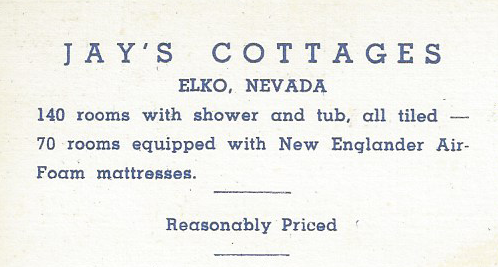
Earliest Known Postmark
Earliest known postmark for the first 140 room version, September 18, 1950. “Marry + Jiggs” wrote to their friend in New Jersey, “Sun. Stopping here tonight. Quite cold crossing desert.”
Second Version of 140 Room Jay’s Cottage post card.
The second version of the 140 room back features a similar thank you message as the fifty room version; “It has been a pleasure to have you as our guest.”
At that point in the message, it changes. From the original “Sincerely hope you will arrive home safely,” to “Sincerely hope you have arrived home safely.”
The second version of the 140 room back added a marketing message at the end, “Tell your friends about us.”
Also note, the letters in the thank you message are now italicized.
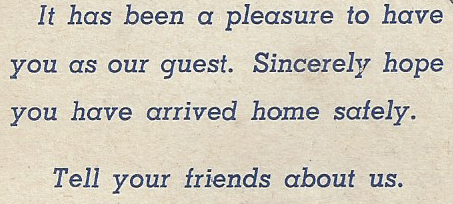
Earliest Known Postmark. The current earliest known postmark is Elko, August 27, 1950.
Third Version of 140 Room Jay’s Cottage post card.
The third version of the 140 room back, uses the message side on the back to market Elko, and offering help to those who want to get married.
The help with the marriage arrangements was not directed to the recipient of the post card, but rather to friends; “If any of your immediate acquaintances with to get married, our ROMONA ROOM IS READY. We make all arrangements.”
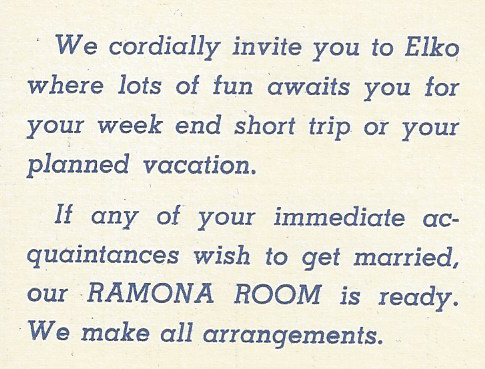
Earliest Known Postmark. Currently, the earliest known postmark is Elko, December 11, 1950.
The Fourth Version of 140 Room Jay’s Cottage post card.
The fourth version of the 140 room back is in the form of a sticker pasted over the printed married arrangement offer.
The sticker message says Jay’s Cottages is the “Largest Motel in Elko.”
Along the Garteiz said “Mediocre accommodations cost as much or more than good accommodations. Always insist on the best. Ours are and . . . THEY DON’T COST ANY MORE.”
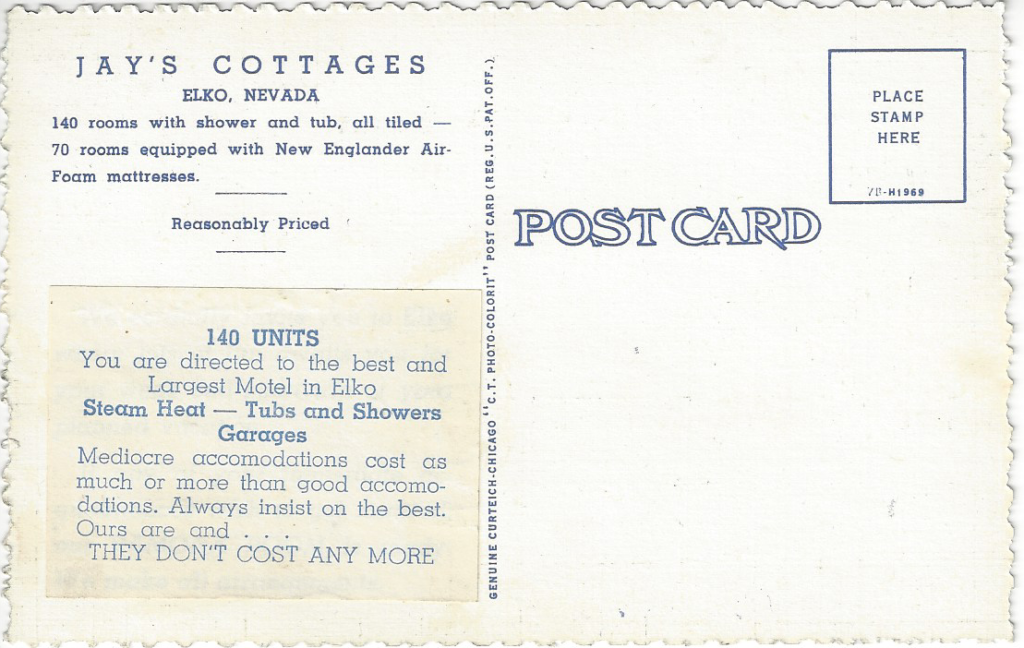
The Fifth Version of 140 Room Jay’s Cottage linen post card.
The fifth version of the 140 room back shows the same single line spacing as the fifth version. The word “New” was dropped from the description of the mattresses.
When ‘new’ was removed from the sentence the space allowed the hyphenated words “Air-Foam” to be on same line.
Interested in determining when Garteiz felt the air-foam mattresses were no longer “New.”
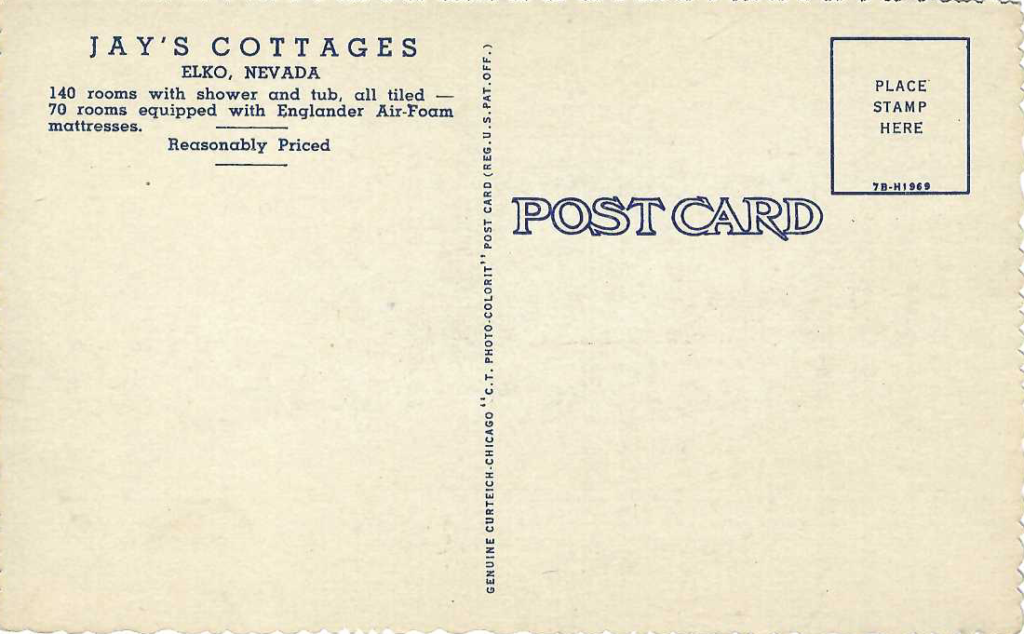
Earliest Known Postmark
Currently, the earliest known postmark of the fifth version is Elko, September 29, 1951.
The Sixth Version and last known version of the
140 Room Jay’s Cottage linen post card.
The sixth version of the 140 room post card has the same caption, describing the motel, as the fifth version.
In addition, there is a thank you message similar to the one found on the second version of the 140 room post card.
The two differences between the second and 6th versions are; dropping the word “New” from the mattresses, and the single spacing between the lines of the caption.
The tight spacing is first seen in the fifth version of the 140 room post card.
Jay’s Cottages Ends its Relationship with
the Curt Teich post card Company.
These are the six known changes to the backs of the Curt Teich printed “Jay’s Cottage” post card. There may be more.
By the late summer of 1953, the last of the original December, 1947 order of 25,000 post cards was all but gone.
Plus the family now owned both sides of the street as well as the service station.
It was time to order new post cards with an updated photographs. For an unknown reason the Garteizs switch companies.
MWM Linen Post Cards
The second linen postcard for “Jay’s Cottages” is described by the Nevada Historical society as “an important document” as it relates to “the post- (World) War (Two) travel boom.”[xii]
The post card is split horizontal view of both sides of the street, with the address between the two views.
On the top are the “Cottages” added in 1948. They were located across the street from the original service station.
The bottom view is of the new two-story ‘cottages.’ JAY’S name can be seen on two sides of the service station. Jay is now associated with the Shell Oil Company.
Note the AAA sign on top of the cottages sign.
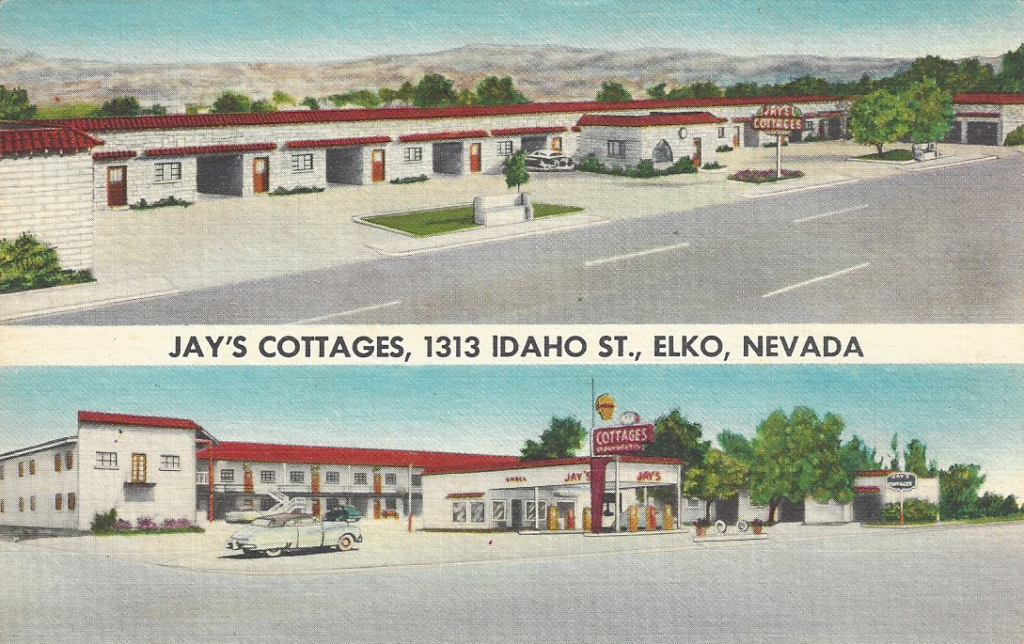
This post card was printed by the Mid-West Map Company (MWM) of Aurora, Missouri.
The “Jay’s Cottages” post cards were ordered through a business called the “Motel Contract Supply Company” of St. Louis, Missouri.
The motel supply company’s credit line is found along the center on the back of the post card where the printing company is usually found.
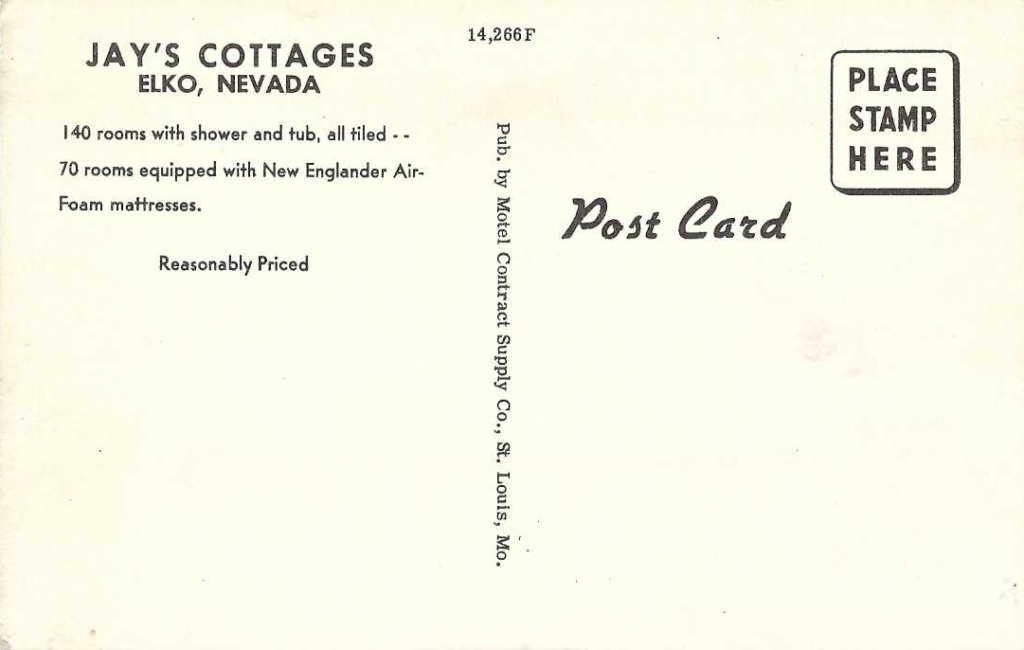
There are three clues on the post card clearly point to MWM as the printer.
The first is the production alphanumeric code is the type MWM used. The listing on the Jay’s Cottages post card is 14,266F.
The second clue that points to MWM as the printer is the font used for the words Post Card on the address side of the card.
The third clue is the design of the stamp box with its rounded edge and drop shadow. That is an MWM design.
Like the Curt Teich post cards, the MWM cards saw a number of changes over time to its back. There are eight known versions of the MWM post cards of Jay’s Cottages.
The total number of post cards Garteiz ordered though the motel supply company is unknown.
There are Eight Known Versions of the MWM post cards printed for
“Jay’s Cottages.”
The first version of the MWM “Jay’s Cottages” Post Card.
The first version of the MWM “Jay’s Cottages” linen post card has the same message on the back of the fifth Curt Teich printed post card.
Interestingly, the word “New” is back in front of “Englander.”
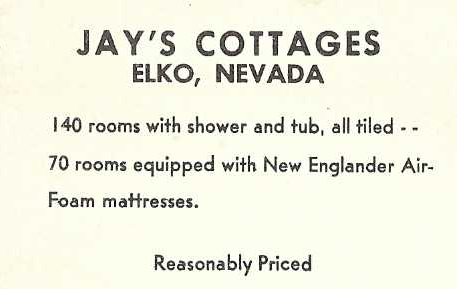
Were these “new” Englander mattresses, or did Gartiez order the MWM post cards at the same the Teich post cards were boasting of “New” Englander mattress.”
Did the Gartiez’ use the Teich post card on one side of Idaho Street, and the MWM post card on the two-story side of the street?
The Second version of the MWM “Jay’s Cottages” Post Card.
The second version of the MWM ‘cottages” post card has the same caption as the first, plus a thank you note; “It has been a pleasure to have you as our guest. Sincerely hope you have arrived home safely. Tell your friends about us.”
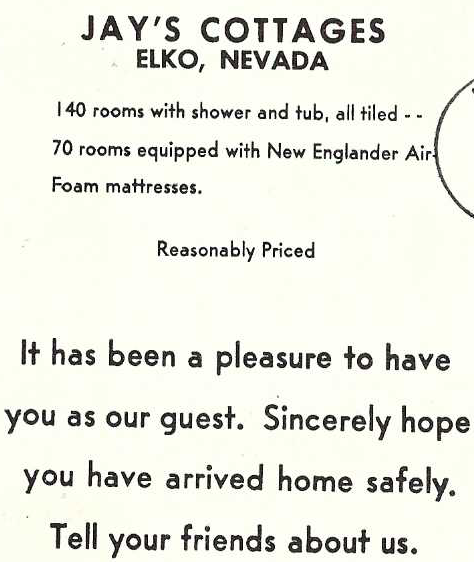
In addition to mailing these post cards to guests after they left, the cards were also available at the motel.
Earliest Known Postmark. Currently, the earliest known postmark is Elko, May 29, 1954. This post card also has a note from the sender; “Dear Mother, Everything is OK so far.”
The Third version of the MWM “Jay’s Cottages” Post Card.
The third version of the MWM post card has two changes.
Garteiz dropped the the word “New” regarding the mattresses.
The second change occurred switching from double spacing between the lines to a single space.
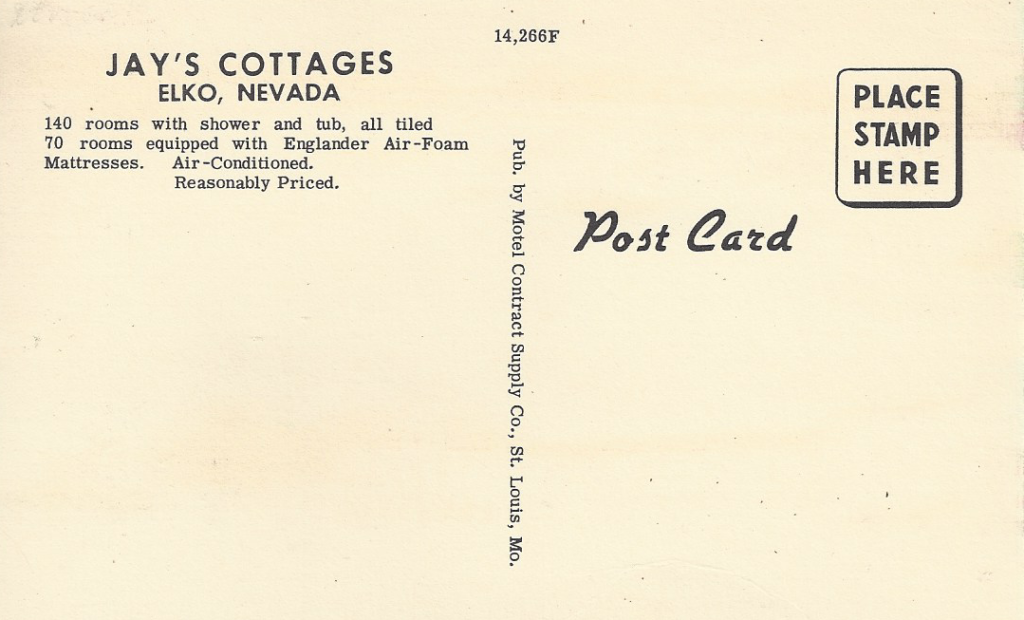
Earliest Known Postmark. The earliest known post mark is Elko, September 19, 1954. The message is from Beulah to her friends in New York. She writes as far as Elko “we can gamble, drink, anything here. The state is wide open. Our door is locked.”
The Fourth version of the MWM “Jay’s Cottages” Post Card
Several changes were made to the fourth version of the MWM post card.
The spacing between the caption lines went from single to double. New was removed from in front of mattresses, while the word “Air-Conditioned” was added after the word “mattresses.”
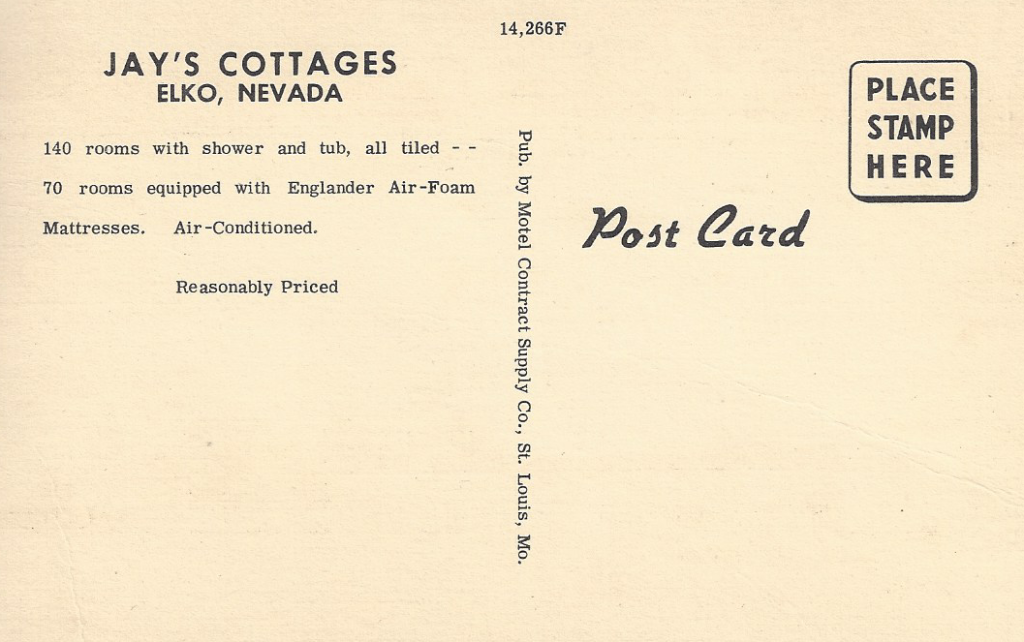
Earliest Known Postmark. The current earliest known post mark is Elko, August 22, 1956. The message, signed “The Tourists” wrote to their “Dear Mom + Pop. This is where we stayed last night. A home away from home.”
The Fifth version of the MWM “Jay’s Cottages” Post Card
The fifth version of the MWM ‘cottages’ post card has the same 140 Rooms caption as the 4th version.
The following changes from the fourth to the fifth version; A marketing note covers the rest of the message side.
The font for both the caption and the marketing message was changed to a bold type face.
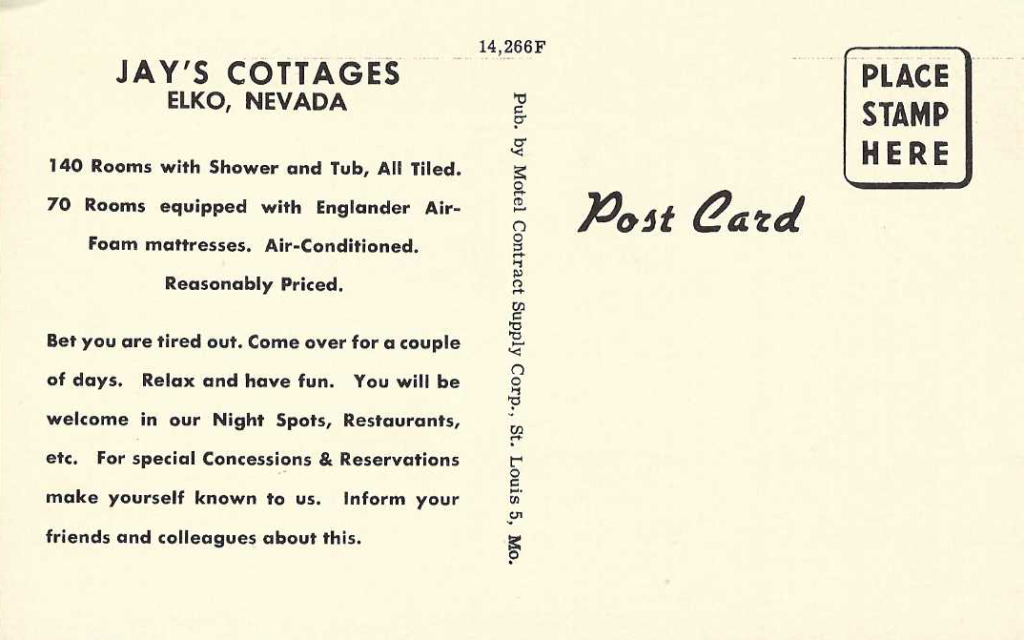
The Sixth version of the MWM “Jay’s Cottages” Post Card
The sixth version of the MWM “cottages” post card returns to the smaller non bold type, and and to single spacing between lines.
The marketing message is gone, leaving room for a message from the guest.
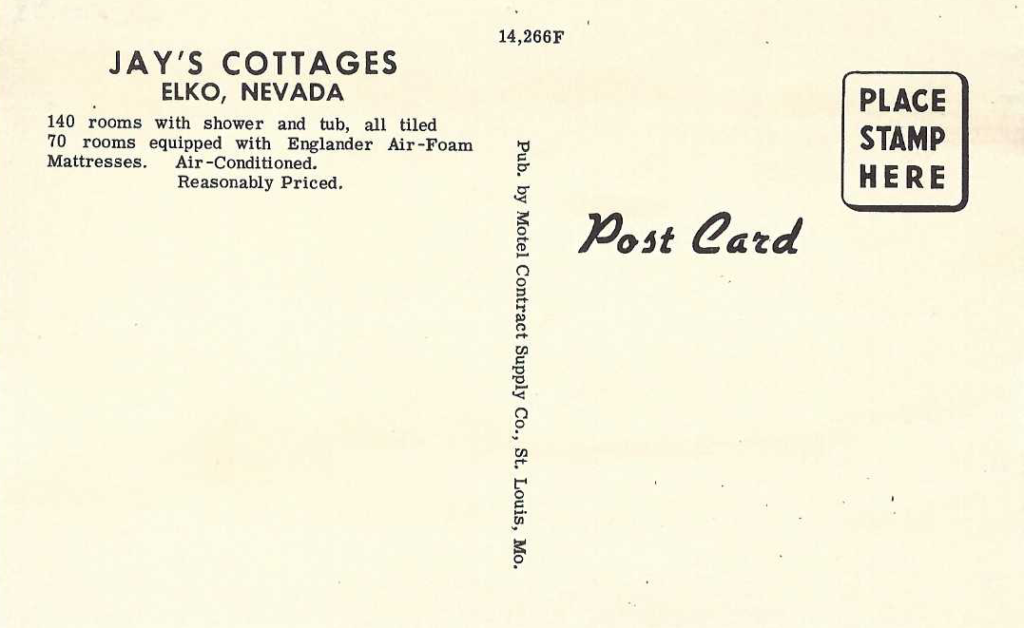
Earliest Known Postmark. The earliest known post mark is Elko, September 8, 1954. The unnamed writer wrote to his uncle in San Francisco, “This is a very nice motel We are greatly pleased. Walter likes it because of the name.”
The Seventh version of the MWM “Jay’s Cottages” Post Card
The seventh version of the MWM “cottages” post card has a turquoise green sticker over the message side of the back.
The message on the sticker is similar to the printed message on the second version of the MWM post card.
The message on the seventh reads; “It has been a pleasure to have you as our guest. We hope you have arrived home safely. Thanks again and tell our friends about us.”
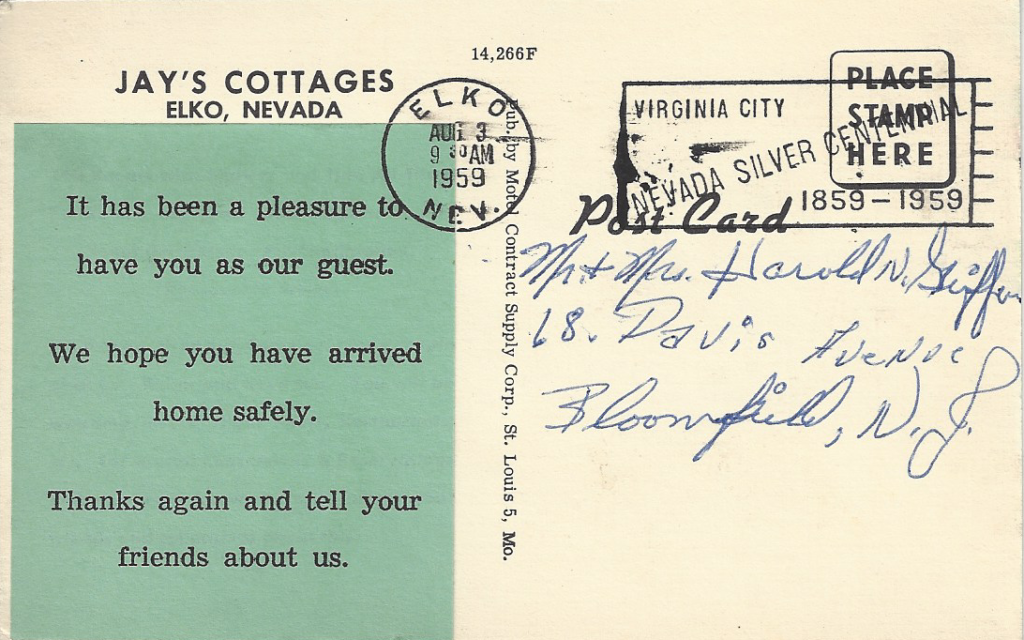
No space is left for a message from the guest.
Earliest Known Postmark. The earliest known post mark is Elko, August 3, 1959. The post card in the collection is postmarked, but without a stamp. The postmark announces the “Nevada Silver Centennial.”
The Eighth version of the MWM “Jay’s Cottages” Post Card
The eighth version of the MWM “cottages” post card has the same basic message as the seventh version.
Added is a mileage chart with five locations, from Reno to Salt Lake City, Utah. 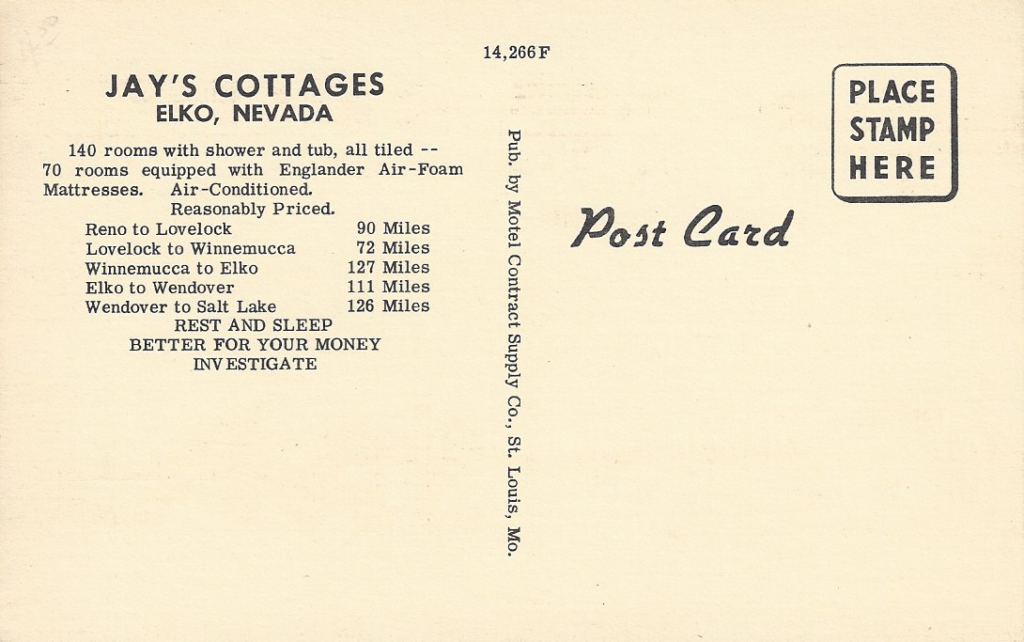
Earliest Known Postmark. The earliest known post mark for the eighth version of the MWM post card is May 2, 1957
The MWM post card was last linen for “Jay’s”
The eight versions of the MWM were the last linen post cards featuring “Jay’s Cottages.”
With the linen post card era coming to an end in the mid-1950’s, the Gartiezs’ moved into the chrome post card world.
The term “chrome” comes from Kodachrome color film and developing process. While black and white photographs on post cards had been produced since the turn of the 20th Century, color photographs on post cards did come into common use until the late 1940’s.
First Known Version of a “chrome” Post Card of Jay’s Cottages
Similar to the MWM linen post card, the first “chrome” post card, features a horizontal split view of “Jay’s Cottages” located on both sides of Idaho Street.
One of the photographs reflects a historic change in the family’s businesses.
Gone is the service station, the business Jay first opened three decades earlier in 1925.
The service station is replaced by a heated swimming pool. The change took place after Jay died in 1960.
The gas station itself was saved. It was moved to Carlin, Nevada where it was turned into a restaurant. Current status, unknown.
The AAA sign is gone from the top of the “Cottages” sign and replaced by “JAY’S.”

The post card was printed by Dexter Press of Nyack, New York. The Dexter Press number for this post card is 52559-B.
The card was produced by Eric J. Seaich though his “Seaich Card & Souvenir Corporation” of Salt Lake City, Utah. His name is also found as the photographer, “Color by Eric J. Seaich.
Seaich was connected all of the chrome post cards for the Garteiz family, including the last one before “Jay’s” was sold.

The caption notes more rooms, up from 70 to 90 of the 140 are “equipped with air-foam mattresses,” and cottages are still “reasonably priced.”
The telephone number, “Republic 8-6222,” also dates the post card to the early 1960’s.
Second Known Chrome Post Card Version of Jay’s Cottages
This is the last post card where the business would be called “Jay’s Cottages.”
Still promoting “reasonably price” rooms, the second known chrome post card was also produced by Eric J. Seaich.
Once again, Seaich took the photograph of the cottages just showing the pool side of the street.
Posed around one corner of the pool, more than a dozen people are seen in and out of the water. 
While not credited with its logo on the back, this Jay’s Cottages post card like the last was printed by Dexter Press.
The company’s alphanumeric production number, E-34072-B is found on the lower left corner on the back of the post card.
Third Known Chrome Post Card of Jay’s Cottages -Motel
The third known chrome of “Jay’s Cottages” reveals several major changes in the operation.
The sign that used to stand in front of the service station with the words “Jay’s Cottages” is gone.
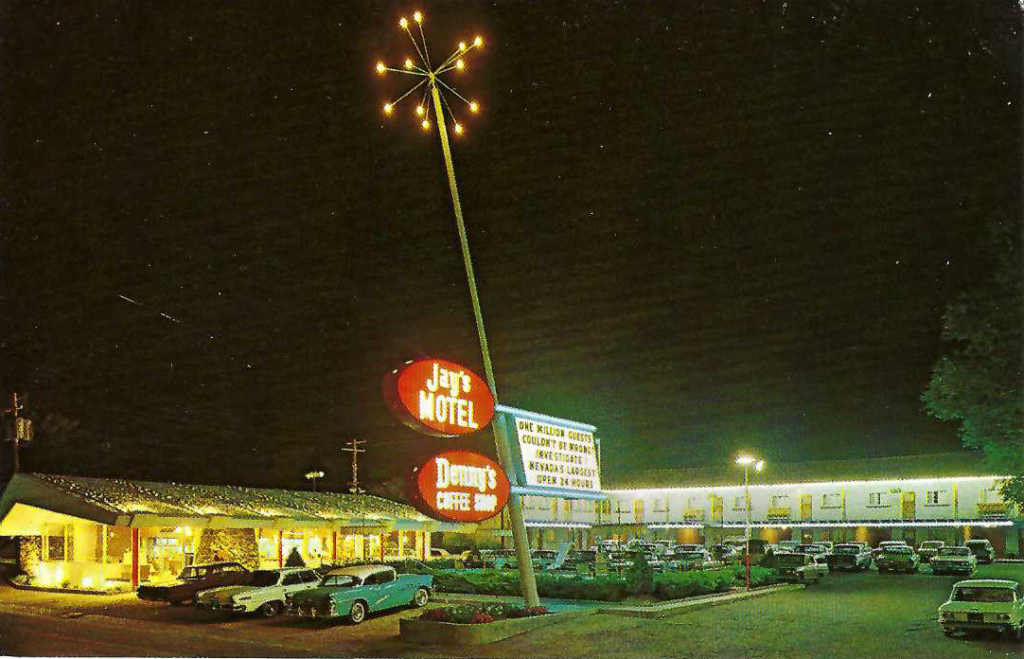
For the first time, a night time photograph is used on a Jay’s post card. The image shows a tall free standing pole topped by a star burst.
Three signs are attached to the pole.
The tallest sign features the new name of the business, “Jay’s MOTEL.”
Next is a changeable billboard type sign that reads, “ONE MILLION GUESTS COULDN’T BE WRONG. INVESTIGATE NEVADA’S LARGEST. OPEN 24 HOURS.”
The bottom sign shows the name of a new business on the corner of the motel property, “Denny’s Coffee Shop.”
The Garteiz family built the restaurant on the corner of their property and in 1962 it was leased to the national restaurant chain, “Denny’s.”
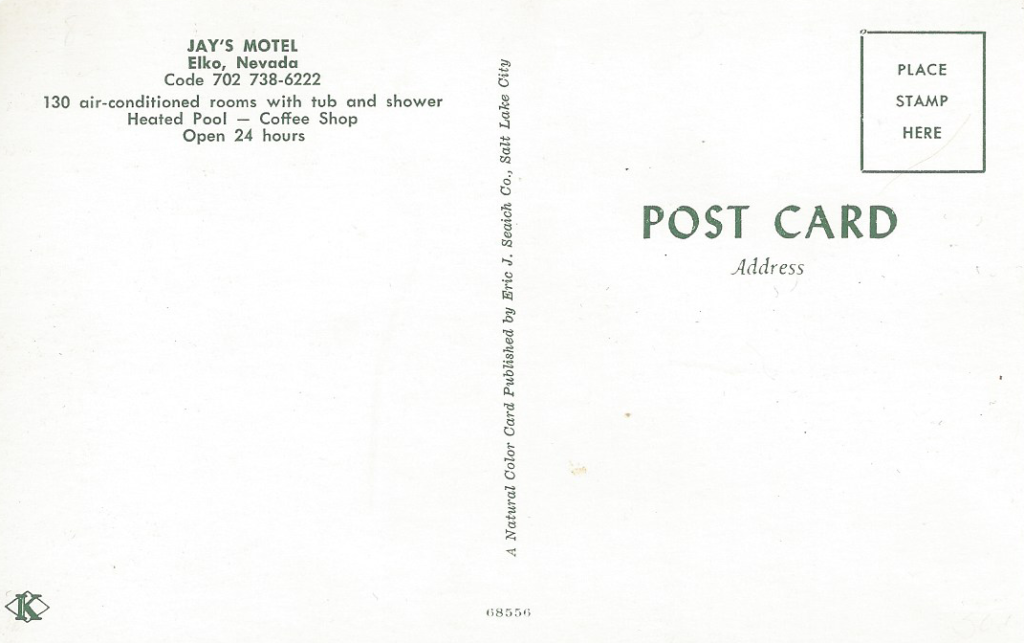
The caption on the back reveals the number of rooms dropped from 140 to 130. And the number of rooms available was reduced from 140 to 130.
Jay’s would no longer promote it has air-foam mattresses.
Gartiez was still using Seaich to produce his post cards. The credit line down the center of the back the post card is “A Natural Color Card Produced by Eric J. Seaich Co., Salt Lake City.”
Seaich used another company to actually print the post cards.
There is also a diamond shaped logo with a K in the center on the lower left side of the back of the post card.
In addition a production number, 68556 is found on bottom of the center of the back.
Fourth Known Chrome Post Card of Jay’s Cottages -Motel
The fourth known chrome of “Jay’s Motel” has the same image on the face as the third chrome post card, as well as the caption on the back stating 130 units were available for rent.
This is the ‘thank you’ version of the third version, with the night time photograph. Same production number, 68556.
The major difference is the additional message on the back, a thank you note in a script font style.
“It has been a pleasure to have
You as our guest and we hope you
have had a safe and enjoyable
trip.
Tell your friends about us.”
The same a diamond shaped logo with a K in the center is found on the lower left side of the back of the post card. The production number, 68556 is the same as found on the fourth chrome post card.
Earliest known version is June 18, 1964 with the Nevada Centennial cancellation.
Fifth Known Chrome Post Card of Jay’s Cottages -Motel
The fifth known chrome of “Jay’s” is a day time scene, taken from a similar angle the fourth chrome post card.
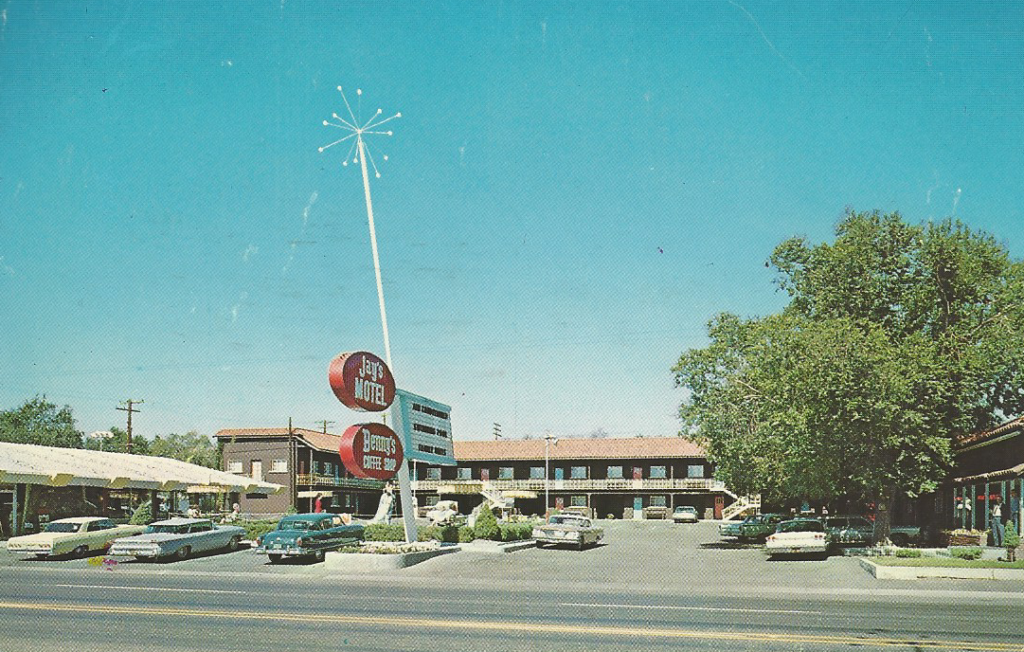
There are two major changes on this post card.
The number of available rooms was dropped from 130 to 100.
And the Denny’s corporation was no longer operating the restaurant. The name was changed to “Benny’s Coffee Shop.”
The billboard sign on the pole is changed to read, in red letters, “AIR-CONDITIONED. SWIMMING POOL” and what looks like “FAMILY RATES”
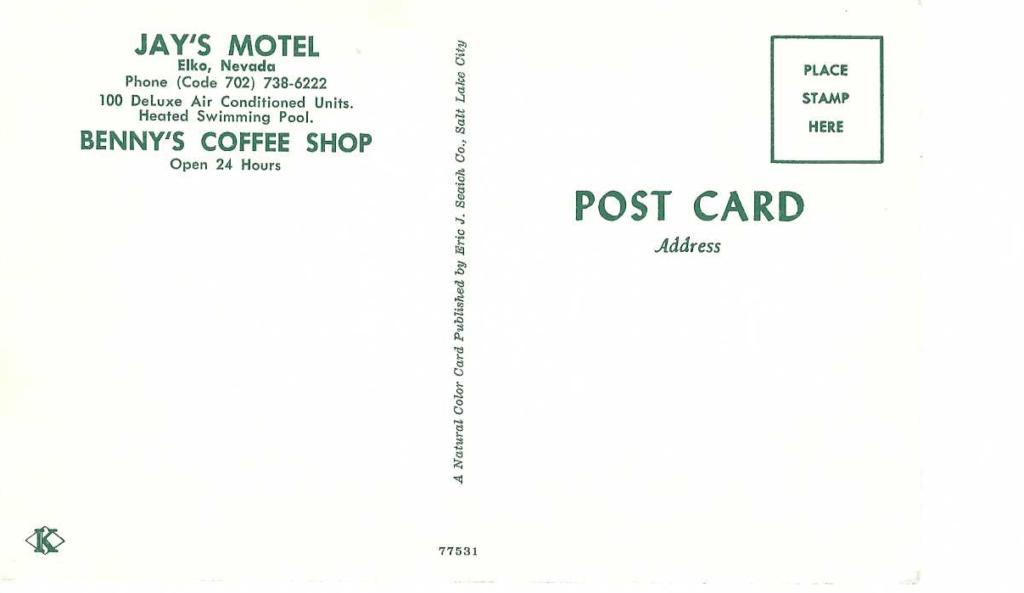
The post card was printed by the same company as the third and fourth chrome. A diamond shaped logo with a K in the center on the lower left side of the back of the post card.
With the new photograph, the production number was changed to 77531.
Sixth and last Known Post Card of Jay’s Motel
While the sixth chrome Jay’s post card uses the same photograph as the fifth version, this one A sixth version of a chrome Jay’s post card, has several interesting changes.
The number of rooms, which had dropped to a low of 100 on the previous post card is now listed at 149, the highest number in the history of Jay’s.
The Garteiz’s also added a “T.V.” in “All Rooms, Some Color.” They also offered “Queen and regular beds.”
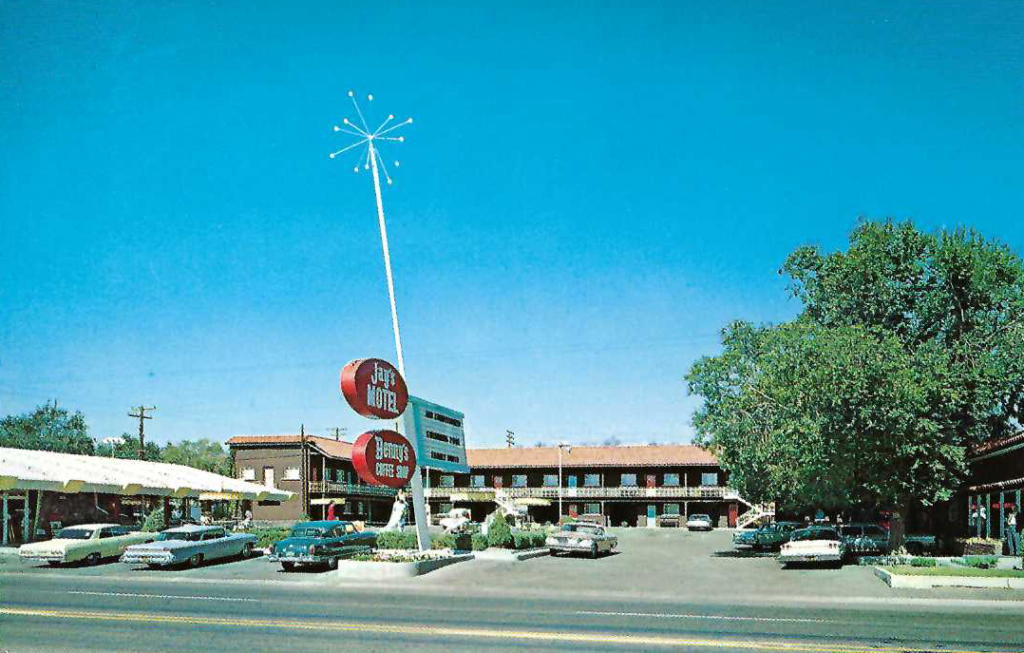
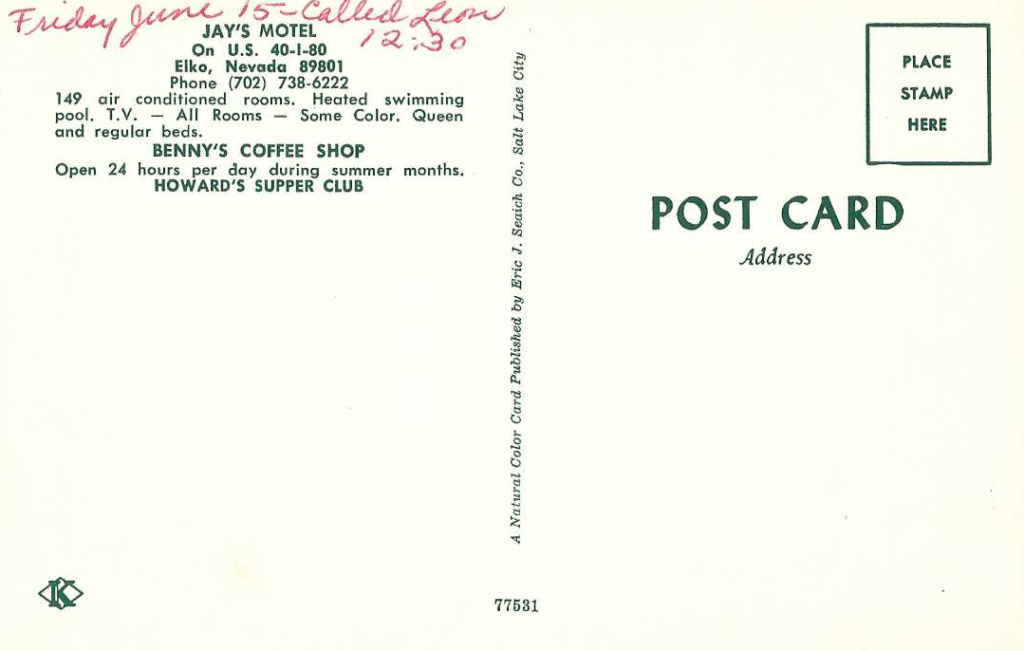
And while “Benny’s Coffee Shop” was still operating the Garteizs added a second restaurant into the same building; “Howard’s Supper Club.”
Howard’s is not seen on any sign, as the photograph used for this post card is the same one used on 77351.
1965 “Jay’s Cottages” and the Garteiz are gone.
Lucile and their son Ray continued to run the motel operation as Jay’s health began to fail in the mid 1950’s.
Then in late 1957, Garteiz placed an advertisement in Los Angeles and San Francisco newspapers offering the “140 UNIT MOTEL for sale by owner. 83,580 sq. ft. ground area. Buildings approximately 50,000 sq. ft., well equipped. Tiled tub and shower baths, steam and hot water heat, fully air-conditioned. Guest capacity 400. Very profitable operation. Suggest personal investigation. Ill health forces sale. JAY’S COTTAGES, Elko, Nevada.” [xiii]
With Jay sick, the service station was closed and the building sold and moved to Carlin, Nevada.
However, the family continued to own and operate the motel.
Two and a half years later, on March 3, 1960, the motel’s namesake “Jay” Garteiz, at the age of 63, died after “a long illness.”[xiv]
Four years later in 1964, the Garteiz family sold all of the cottages to 2 couples from Washington.
By 1965, the two of the Garteiz children, Dorothy and Paul had moved to southern California. Their mother Lucile along with Ray and his wife, had moved to Sacramento, California.
The forty years of the Garteiz family in Elko, Nevada hospitality business had come to an end.
Today, if you look real close, you can still see “Jay’s Cottages,” on both sides of the 1300 block of Idaho Street.
On the north side, the original “cottages” with garages are now small shops in the “Rancho Plaza Shopping Mall.”
Across the street, the two-story “Jay’s Cottages” is now a “Budget Inn.”
When the cottages were all “Jay’s” the mail came to one place 1313 Idaho Street.
Today, the “Budget Inn” is at 1349 Idaho Street, and the shopping mall is the lucky one with the historic 1313 Idaho Street address.
There are twenty known post cards that mark the history of Jay and his family building “the largest accommodation in the City of Elko for the traveling public.”
A special family to reflects the history of “Mom and Pop” motels.
[i] “Jay’s Motel In Elko Sold,” May 24, 1964, Nevada State Journal, page 37.
[ii] “Jay’s Cottage,” post card, December 1, 1947, Curt Teich Company, Chicago, Illinois.
[iii] “Rewrite!,” July 8, 2000, Elko (Nevada) Daily Free Press, page A4.
[iv] http://www.delamare.unr.edu/Maps/digitalcollections/nvmaps/highway.html
[v] “Camp Ground Leased To Woman by City,” March 28, 1936, The Salt Lake Tribune, page 26.fr
[vi] “Rewrite!,” Elko (Nevada) Daily Free Press, July 20, 1996, page 11.
[vii] “Cottage Building Planned In Elko,” August 5, 1948, Reno (Nevada) Gazette-Journal, page 8.
[viii] https://archive.org/details/nevada-teich-geo-index/page/n27 .
[ix] https://archive.org/details/nevada-teich-geo-index/page/n27 .
[x] “13,” May 8, 1938, Nevada State Journal (Reno) page 9.
[xi] “Building Permits High for Elko,” September 27, 1949, Reno (Nevada) Evening Gazette, page 7.
[xii] “Photography,” Summer, 2007, Nevada Historical Society Quarterly, page 175.
[xiii] “140 Unit Motel For Sale,” Classified advertisement for “Jay’s Cottages,” October 10, 1957, Los Angeles Times, page 21. “140 Unit Motel for sale,” Classified advertisement for “Jay’s Cottages,” October 12, 1957, The San Francisco Examiner, page 31.
[xiv] “Motel Owner Rites held,” March 12, 1960, Reno (Nevada) Gazette-Journal, page 3.
